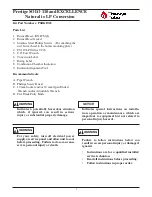
26 ENGLISH
In the case of right bevel cut
(a) (b)
(c) (d)
1
2
1.
Inside corner
2.
Outside corner
Table (A)
–
Molding
position
in the
figure
Bevel angle
Miter angle
52/38°
type
45° type
52/38°
type
45° type
For
inside
corner
(a)
Right
33.9°
Right
30°
Right
31.6°
Right
35.3°
(b)
Left
31.6°
Left
35.3°
For
outside
corner
(c)
(d)
Right
31.6°
Right
35.3°
Table (B)
–
Molding
position in
the figure
Molding
edge against
guide fence
Finished
piece
For inside
corner
(a)
Wall contact
edge should
be against
guide fence.
Finished
piece will be
on the Right
side of blade.
(b)
Ceiling
contact edge
should be
against guide
fence.
For outside
corner
(c)
Finished
piece will be
on the Left
side of blade.
(d)
Wall contact
edge should
be against
guide fence.
Example:
In the case of cutting 52/38° type crown molding for
position (a) in the above figure:
•
Tilt and secure bevel angle setting to 33.9° RIGHT.
•
Adjust and secure miter angle setting to 31.6°
RIGHT.
•
Lay crown molding with its broad back (hidden)
surface down on the turn base with its WALL
CONTACT EDGE against the guide fence on the
saw.
•
The finished piece to be used will always be on
the RIGHT side of the blade after the cut has been
made.
Crown molding stopper
Optional accessory
Crown molding stoppers allow easier cuts of crown
molding without tilting the saw blade. Install them on the
turn base as shown in the figures.
At right 45° miter angle
►
Fig.49:
1.
Crown molding stopper L
2.
Crown mold-
ing stopper R
3.
Turn base
4.
Guide fence
At left 45° miter angle
►
Fig.50:
1.
Crown molding stopper L
2.
Crown mold-
ing stopper R
3.
Turn base
4.
Guide fence
Position crown molding with its WALL CONTACT EDGE
against the guide fence and its CEILING CONTACT EDGE
against the crown molding stoppers as shown in the figure.
Adjust the crown molding stoppers according to the size of the
crown molding. Tighten the screws to secure the crown mold-
ing stoppers. Refer to the table (C) for the miter angle.
►
Fig.51:
1.
Guide fence
2.
Crown molding stopper
(a) (b)
(c) (d)
1
2
1.
Inside corner
2.
Outside corner
Table (C)
–
Molding position
in the figure
Miter angle
Finished
piece
For inside
corner
(a)
Right 45°
Save the right
side of blade
(b)
Left 45°
Save the left
side of blade
For outside
corner
(c)
Save the right
side of blade
(d)
Right 45°
Save the left
side of blade
Cutting aluminum extrusion
►
Fig.52:
1.
Vise
2.
Spacer block
3.
Guide fence
4.
Aluminum extrusion
5.
Spacer block
When securing aluminum extrusions, use spacer blocks
or pieces of scrap as shown in the figure to prevent
deformation of the aluminum. Use a cutting lubricant
when cutting the aluminum extrusion to prevent build-up
of the aluminum material on the circular saw blade.
WARNING:
Never attempt to cut thick or
round aluminum extrusions.
Thick or round alumi-
num extrusions can be difficult to secure and the work
may loosen during the cutting operation which may
result in loss of control and serious personal injury.
Summary of Contents for LS1019
Page 2: ...2 Fig 1 10 11 12 14 15 3 2 4 5 8 7 9 13 6 1 16 17 18 19 20 21 Fig 2 ...
Page 3: ...3 7 8 5 6 1 2 3 4 9 10 11 14 13 12 15 Fig 3 1 2 Fig 4 1 2 3 4 4 Fig 5 ...
Page 4: ...4 2 1 Fig 6 3 1 2 Fig 7 1 Fig 8 1 Fig 9 3 1 2 Fig 10 1 Fig 11 ...
Page 5: ...5 1 2 3 4 6 5 Fig 12 1 Fig 13 1 Fig 14 1 2 3 Fig 15 1 2 Fig 16 ...
Page 6: ...6 1 2 3 4 Fig 17 1 Fig 18 1 Fig 19 1 2 Fig 20 1 Fig 21 1 Fig 22 ...
Page 7: ...7 1 Fig 23 3 1 2 Fig 24 1 2 3 Fig 25 1 Fig 26 1 Fig 27 A B Fig 28 1 Fig 29 ...
Page 8: ...8 1 2 3 Fig 30 3 1 2 Fig 31 1 2 4 4 5 5 3 Fig 32 1 2 Fig 33 1 2 3 4 5 6 Fig 34 ...
Page 9: ...9 1 2 3 Fig 35 1 2 Fig 36 1 Fig 37 1 2 Fig 38 1 2 3 1 2 3 4 4 Fig 39 1 2 3 Fig 40 ...
Page 10: ...10 1 2 3 4 Fig 41 1 2 3 Fig 42 1 2 Fig 43 1 Fig 44 1 Fig 45 ...
Page 12: ...12 1 Fig 53 Fig 54 2 1 2 3 Fig 55 1 Fig 56 1 2 Fig 57 1 2 3 Fig 58 Fig 59 ...
Page 13: ...13 1 2 Fig 60 1 2 3 4 5 Fig 61 1 2 3 4 5 Fig 62 1 2 Fig 63 1 Fig 64 ...
Page 14: ...14 1 Fig 65 ...
Page 179: ...179 ...
















































